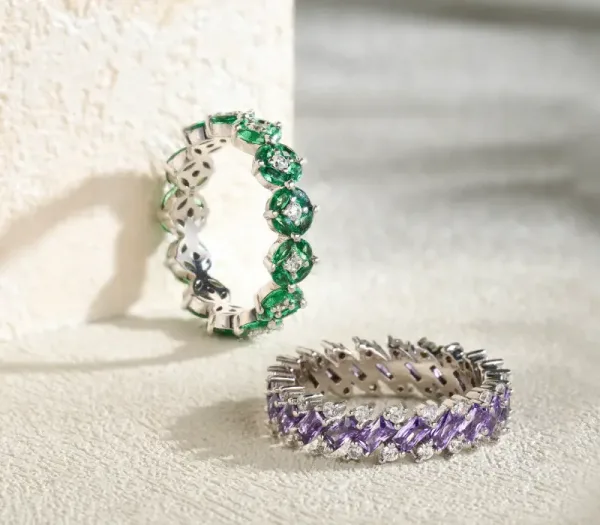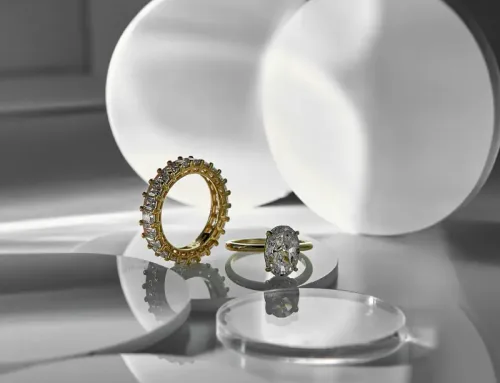The Charm of Colored Gemstone Jewelry
Colored jewelry has emerged as an important direction in modern jewelry design, increasingly capturing the attention of consumers. Unlike traditional transparent diamond jewelry, colored jewelry combines unique aesthetic appeal with rich colors and cultural meanings, often becoming a symbol of personal expression. Whether crafted from precious natural gemstones or vibrant synthetic stones, each piece of colored jewelry reflects the infinite magic of nature.
The Appeal of Colored Jewelry
Colored jewelry has gained popularity for more than just its visual impact. It allows wearers to showcase their unique personalities. Different colored gemstones represent various emotions and symbolic meanings. For instance, blue gemstones symbolize calmness and wisdom, while red gemstones often stand for passion and energy. Colored jewelry becomes more than just an accessory—it conveys emotions and individuality.
Common Natural Colored Gemstones
- Sapphire
Sapphire ranks among the most iconic colored gemstones. While its classic blue color remains the most well-known, sapphires also come in hues of pink, yellow, and green. Widely used in rings, earrings, and necklaces, sapphire’s hardness, second only to diamond, makes it ideal for everyday wear. People regard blue sapphires as symbols of loyalty and wisdom, which is why they frequently appear in engagement and wedding rings. - Jade
Jade holds a deep cultural significance, especially in Chinese traditions. Its green varieties are the most common, but jade can also come in white, yellow, and even purple. This gemstone represents good luck and happiness, making it a favorite among many jewelry enthusiasts. - Emerald
Emerald is another beloved green gemstone, known for its deep green hue and remarkable beauty. As one of the four major gemstones, emeralds exhibit a range of green shades, from light to dark. It symbolizes life, prosperity, and wealth, making it a popular choice for jewelry that represents abundance and well-being. - Ruby
The striking red of ruby ranges from vivid red to deep burgundy, offering a wide spectrum of hues. Known for symbolizing love and passion, ruby is an essential component of many timeless jewelry designs. Its durability, closely matched to that of diamonds, makes ruby a fantastic choice for long-lasting jewelry. - Amethyst
Amethyst, with its elegant purple tones, is a widely admired gemstone. It represents calmness, mystery, and creativity, and designers often use it in necklaces and earrings. Amethyst’s color varies from pale lavender to deep purple, and it is particularly popular among women. - Peridot
Peridot showcases a unique green or yellow hue and often stands alone in jewelry designs. With its fresh color and noble appearance, peridot is perfect for summer wear, exuding vibrancy and energy.
Synthetic Colored Gemstones
Alongside natural gemstones, synthetic colored gemstones have carved out their own place in the market. These lab-created stones are often more colorful and affordable, making them particularly appealing to younger consumers.
- Synthetic Sapphire and Ruby
These lab-grown gemstones share visual similarities with their natural counterparts but tend to have more saturated colors. Designers often use synthetic sapphires and rubies for larger pieces of jewelry, such as earrings and necklaces, especially in markets where demand is high, and consumers are more price-sensitive. - Lab-Grown Diamonds and Colored Diamonds
Lab-grown diamonds and colored diamonds have gained significant popularity in recent years. These diamonds, while visually indistinguishable from natural diamonds, offer consumers the ability to purchase stones in a variety of colors, such as blue, pink, and yellow, at a more affordable price point. As manufacturing processes become more advanced, these synthetic diamonds cater to the growing desire for personalized jewelry.
Trends in Colored Jewelry Design
As consumer tastes evolve, colored jewelry design is shifting toward greater diversity and personalization. Jewelry designers are now focusing not just on color combinations but also on how different materials interact to create unique effects. For instance, pairing rose gold with emerald, or sapphire with platinum, results in rich, layered designs that are visually captivating.
Additionally, stacking jewelry has become a prominent trend. Consumers express their creativity and individuality by stacking rings or bracelets of different colors. This trend allows for endless combinations, making it possible to create a piece of jewelry that feels truly one-of-a-kind.
The Future of Colored Jewelry
Market research indicates that the demand for colored jewelry will continue to grow. As consumers seek personalized and customizable options, colored gemstones—whether natural or synthetic—will play an increasingly important role in the jewelry market. In emerging markets, consumers’ growing appreciation for unique designs will help solidify colored jewelry as a mainstream trend.
Moreover, with sustainability becoming a key consideration, colored gemstones made from ethical and sustainable resources, such as laboratory-grown stones, will appeal to environmentally conscious buyers. These gemstones not only offer aesthetic appeal but also align with consumers’ ethical values.
Conclusion
Colored gemstone jewelry offers a vibrant and symbolic alternative to traditional jewelry, showcasing a broad spectrum of colors, meanings, and personalities. Whether created from natural stones or synthesized in a lab, colored gemstones provide visual delight and emotional resonance. As market demand and consumer tastes evolve, colored jewelry will continue to carve out an influential place in the jewelry industry, sparking creativity and inspiring new designs.
keyword: custom gold jewelry, custom silver jewelry, custom rings, custom earrings, custom necklace, custom bracelets…







